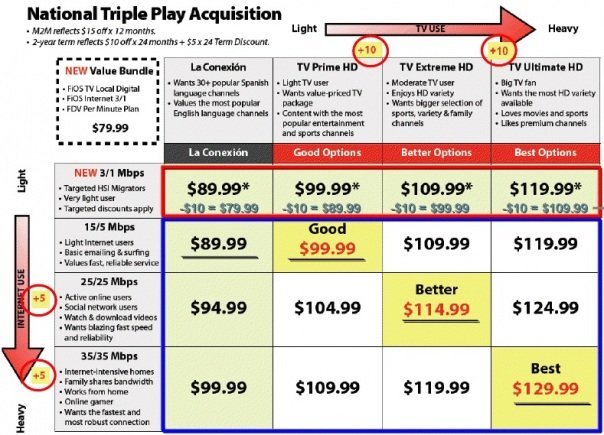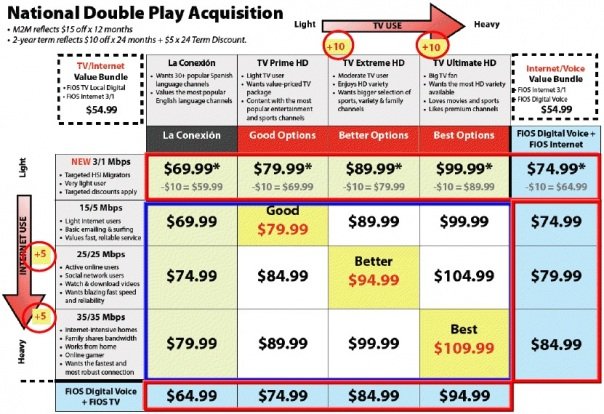 Verizon announced Monday that it is unbundling data plans from its video subscriptions, providing a more flexible offering to its customers. By doing so, the telco enables its FiOS customers for the first time to pick and choose the data plans they want to purchase without them being tied to a certain number of video channels. The ability to do so speaks to the growing importance of broadband to their customers in relation to the amount of television that they watch.
Verizon announced Monday that it is unbundling data plans from its video subscriptions, providing a more flexible offering to its customers. By doing so, the telco enables its FiOS customers for the first time to pick and choose the data plans they want to purchase without them being tied to a certain number of video channels. The ability to do so speaks to the growing importance of broadband to their customers in relation to the amount of television that they watch.
FiOS previously marketed its video, broadband and phone services in a “good, better, best” fashion, ensuring that double- and triple-play subscribers that wanted the fastest broadband would also have to pay for the most robust TV package. In that way, if you wanted its 35Mbps up- and down-stream broadband, you had to go whole-hog and purchase a $129.99 triple-play package or $109.99 double-play package. Same goes for those that wanted the biggest TV package but only wanted Verizon’s starter for broadband services.

But now it’s breaking down those bundles. With its new package options, Verizon subscribers can create more personalized plans, enabling broadband addicts to, for instance, get Verizon’s 35 Mbps broadband package with its smallest pay TV package for $109.99 triple-play and $89.99 in a double-play package, enabling them to save roughly $20 a month each way. Verizon also has double-play options for high-speed Internet and voice starting at $74.99.
Verizon’s broadband packages increase by $5 for each 10Mbps increase in speeds, while video packages increase by $10 as they step up from about 200 channel to nearly 400 channels. At the same time, the margin difference between offering higher-speed broadband or more cable channels is pretty dramatic.

Arturo Picicci, director of product management at Verizon, said the new plans are all about providing different segments of customers the right bundles. In particular, he said that Verizon is seeing younger customers demand higher broadband speeds with less TV networks.
Choosing more broadband is actually beneficial to operators because data margins are much higher than video margins. Since Verizon has to share revenues from video services with content partners, a portion of any incremental revenues it receives from subscribers ends up being passed on to partners. But since Verizon has already invested in the infrastructure required to deliver that kind of speed over its fiber-to-the-home network, the incremental cost of delivering higher-speed broadband speeds is extremely low. While that’s a plus for Verizon, Picicci said the new bundles are more about increasing sales and penetration among different segments.
Verizon isn’t the only pay TV operator and ISP looking to leverage its broadband services as consumers increasingly turn to Internet video services for entertainment. At an investor conference last week, Time Warner Cable CEO Glenn Britt said his company sees an opportunity to capture broadband-only subscribers. Furthermore, he said that broadband was becoming Time Warner Cable’s primary product.
Photo courtesy of (CC BY 2.0) Flickr user slgckgc
Related content from GigaOM Pro (subscription req’d):
- Connected Consumer Q1: The Over-the-Top vs. Pay TV Battle Heats Up
- The Ultimate Guide To TV Everywhere
- Note: Telco Strategies for Over-the-Top Video
